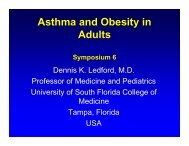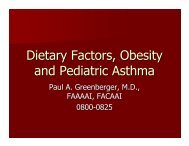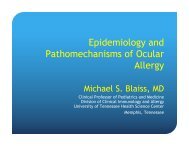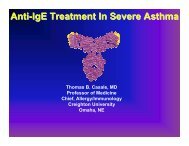Dubai Final-v20.indd - World Allergy Organization
Dubai Final-v20.indd - World Allergy Organization
Dubai Final-v20.indd - World Allergy Organization
Create successful ePaper yourself
Turn your PDF publications into a flip-book with our unique Google optimized e-Paper software.
ABstrACts<br />
participated in this study. We measured urinary leukotrien E4 (U-ltE4) level under stable asthma condition, using Cayman’s EiA<br />
kit after purification by HPlC, as we reported previously. AiA patients were classified into three groups, 1) patients with mild to<br />
moderate asthma which was controlled at less than ginA step 3 treatment,2) patients with stable but severe asthma which was<br />
well controlled at ginA step 4 treatment, and 3) patients with difficult-to-treat asthma which was not controlled at ginA step 4<br />
treatment.<br />
results: the AiA groups 1-3 showed median U-ltE4 concentrations 108, 259, and 582 pg/mg creatinine, respectively. there was no<br />
significant difference between patients with mild to moderate asthma and healthy controls. On the other hand, the concentrations of<br />
U-ltE4 in patients with severe but stable AiA patients and difficult-to-treat AiA patients significantly increased according to asthma<br />
severity as compared with AiA patients with mild to moderate asthma.<br />
Conclusion: Cyslt overproduction may be related to the asthma severity in AiA patients.<br />
1306<br />
CorrElaTion BETWEEn SPiromETrY rESUlTS anD BoDY maSS inDEX in PaTiEnTS WiTH aSTHma<br />
Agondi, r. C. , Bisaccioni, C. , ribeiro, m. , Kalil, J. and giavina-Bianchi, P.<br />
Clinical immunolgy and <strong>Allergy</strong>, sao Paulo University, sao Paulo, Brazil.<br />
Background: studies have suggested that asthma in obese individuals differs from the classic asthma phenotype, presenting as<br />
a disease that is more difficult to control and that does not respond as well to inhaled corticosteroids. the objective of the present<br />
study was to determine whether obesity, age or a combination of the two are associated with abnormal spirometry results in<br />
patients with asthma.<br />
method: this was an observational, cross-sectional, retrospective study involving patients over 18 years of age who had been<br />
diagnosed with asthma. We evaluated the results of spirometric tests conducted between February of 2009 and August of 2009.<br />
the patients were classified in accordance with two criteria: body mass index (Bmi) and age.<br />
results: We evaluated 453 patients and 453 corresponding sets of spirometry results. in the present study, the pulmonary function<br />
parameters were negatively correlated with Bmi. in the obese group, the mean FEV value was 17.4% lower than that observed in<br />
1<br />
the normal-weight group. Within that group, the number of abnormal spirometry results was significantly higher among the patients<br />
≥ 60 years of age than among those 18-59 years of age. the proportion of females was also higher in the obese group.<br />
Conclusion: Our results indicate that FEV and FVC decrease significantly in proportion to increases in Bmi and age. Because<br />
1<br />
obesity is yet another factor that makes asthma control difficult, the weight of asthma patients should be closely monitored.<br />
1307<br />
PrEValEnCE oF BronCHial aSTHma anD iTS aSSoCiaTion WiTH SmoKing HaBiTS among aDUlT PoPUlaTion in rUral<br />
arEa<br />
Parasuramalu, B. g. 1 , Huliraj, n. 2 , B m, r. 1 , s P, P. K. 1 , Dr, g. 1 and n r, r. m. 1<br />
1 2 Department of Community medicine, Kempegowda institute of medical sciences, Bangalore, india. Department of thoracic<br />
medicine, Kempegowda institute of medical sciences, Bangalore, india.<br />
Background: Only few studies have been conducted in rural areas in india to study the relationship of active tobacco smoking in<br />
bronchial asthma. Hence the present study was conducted with the objectives: 1. to find out the prevalence of bronchial asthma. 2.<br />
to find out the association between tobacco smoking and bronchial asthma. materials and methods: A cross sectional study was<br />
conducted in the rural field practice area of Kempegowda institute of medical sciences, Bangalore. totally 3194 adult individuals<br />
(18-70years) were selected from 30 villages (clusters) using cluster-sampling technique. On visiting each house, previously<br />
validated and standardized translated Kannada version questionnaire was administered. individuals with symptoms suggestive of<br />
asthma were subjected for clinical examination for the diagnosis of asthma. the data was compiled and analyzed. results: Among<br />
the 3194 respondents, 1518 (47.5%) were males & 1676 (52.5%) were females. the prevalence of bronchial asthma was 2.88%.<br />
the prevalence of asthma was higher among those reporting a history of current smoking. Among current smokers the number of<br />
cigarettes/ bidis/ hookah smoked daily did not differ (p>0.05) between individuals without asthma and with asthma, whereas the<br />
mean number of years of smoking did differ (p

















